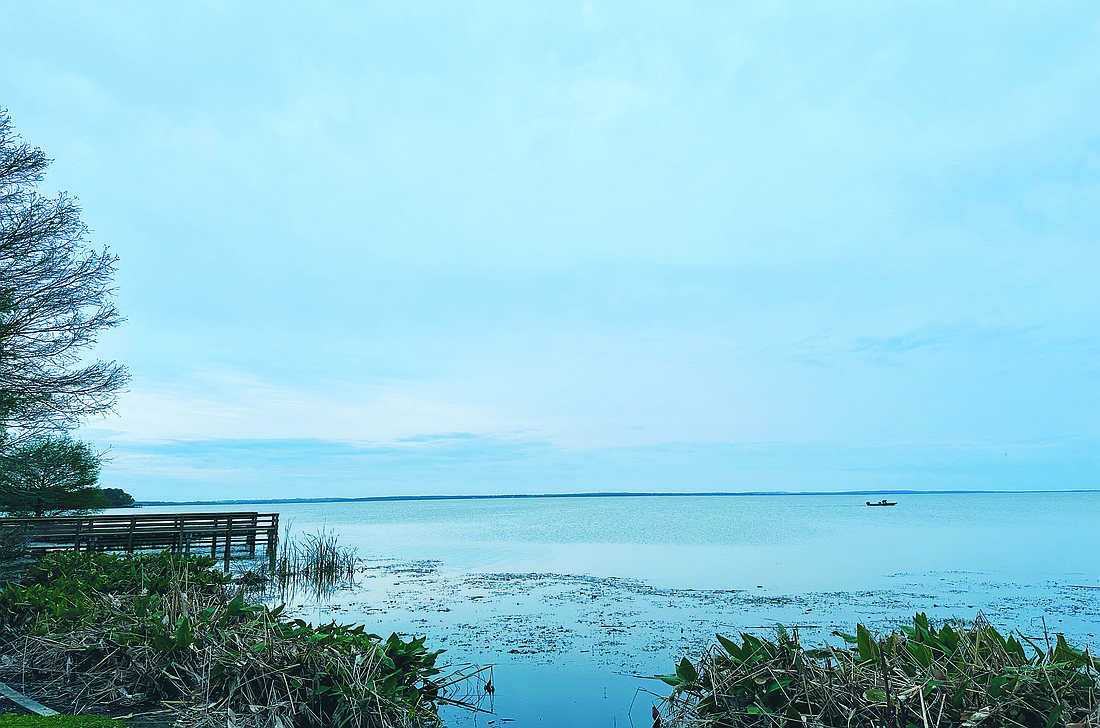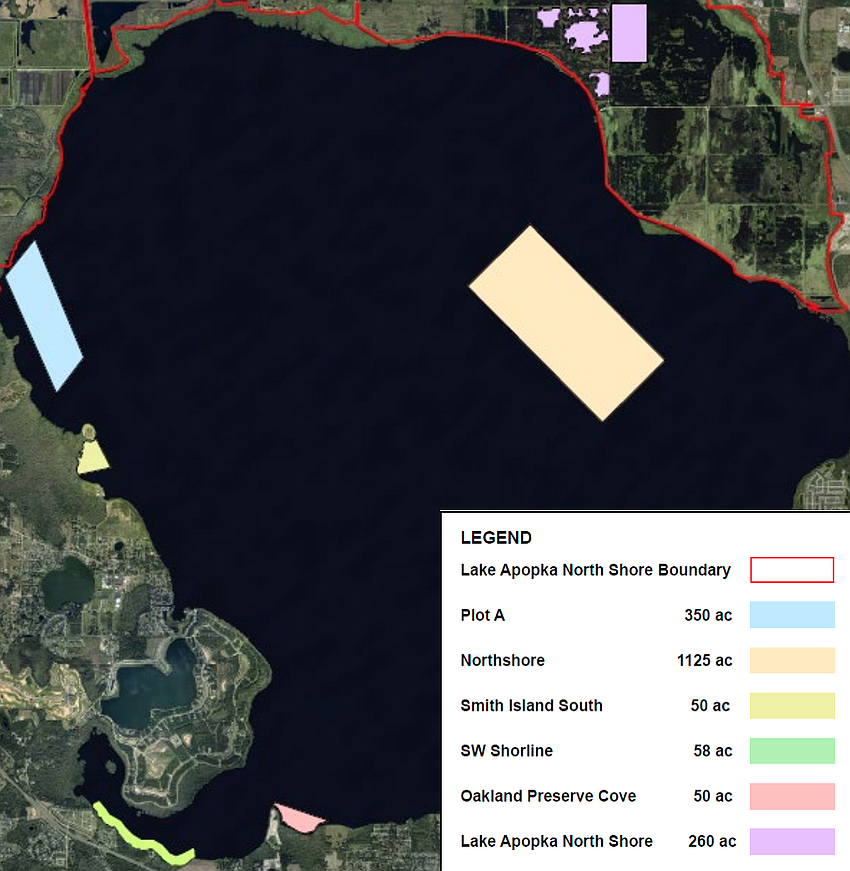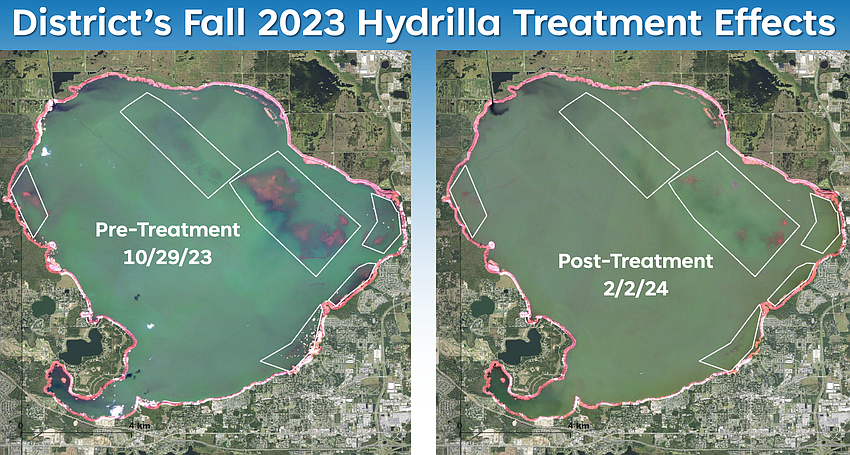- July 26, 2024
-
-
Loading

Loading

The St. Johns River Water Management District hosted a community meeting Tuesday, March 5, at Tanner Hall in Winter Garden to give updates on Lake Apopka restoration and vegetation management.
At the meeting, Mary Ellen Winkler, assistant executive director for SJRWMD, announced the district is aiming to treat 1,633 acres of Lake Apopka for hydrilla by airboat come spring 2024.
The SJRWMD’s treatment plan proposes three new treatments at Smith Island, Gourd Neck and the Oakland Nature Preserve. In addition, follow-up treatments in the fall would be given to a 350-acre area along the northwest shore of Lake Apopka, east of Ferndale, as well as to a 1,125-acre area described as the north shore.
The district hopes the treatment will be conducted before the end of April. However, the exact timing is contingent upon weather conditions and lake-related activities.
“Our objective with these treatments is twofold: to reduce hydrilla in Lake Apopka helping safeguard our continued ability to fulfill our mission of providing regional flood protection, while simultaneously promoting the growth of native aquatic vegetation,” said SJRWMD director Mike Register. “By establishing native vegetation, we’re not only fostering a healthier ecosystem but also preserving our flood protection capabilities, ensuring a balanced and sustainable approach in Lake Apopka restoration efforts.”

LAKE LIFE
The SJRWMD is an environmental regulatory agency whose work is focused on ensuring a long-term supply of drinking water and to protect and restore the health of water bodies in the district’s 18 counties in northeast and east-central Florida.
Lake Apopka is the fourth largest lake in Florida — more than 30,000 acres in size — and is the headwaters of the Ocklawaha Chain of Lakes. The lake was Central Florida’s original tourist attraction.
The SJRWMD and partners have worked since the 1980s to improve the lake’s water quality and habitat. Over the last almost 40 years, the state and the district has invested about $200 million into bringing the lake back to life.
Lake Apopka’s water quality restoration has been based on a multipronged approach of diet and exercise. “Diet” has focused on reducing the amount of phosphorus entering the lake. The largest diet improvement occurred following the legislature’s 1996 direction to the district to buy out the farms on the lake’s north shore.
This area, formerly a floodplain marsh, was diked, drained and put into agricultural production in the 1940s. Phosphorus from these farms fueled the continuous algal bloom that shaded the lake’s vegetation and caused the bass fishery to collapse.
Key to reducing phosphorus loading from the north shore was restoring the area’s wetlands to reduce the volume of nutrient-laden water pumped to the lake. Now, discharges can be treated to inactivate phosphorus, and in 2003 the passage of the Lake Apopka Stormwater Rule enhanced the lake’s diet to the entire watershed.
“Exercise” is removal of phosphorus already in the lake, which has included harvest of rough fish, largely gizzard shad, from the lake and operating the marsh flow-way to continuously filter algae, suspended solids and associated nutrients.
The combined effect of the diet and exercise has been a dramatic improvement in water quality.
Since the late 1980s, phosphorus concentrations have declined 69% and water clarity increased 93%, as of the end of 2023. The recovery of clearer water and return of sunlight to the lake’s bottom caused the regrowth of submerged aquatic vegetation, which had been missing for 50 years, and the critical bass habitat needed for recovering sportfish populations.
NEXT STEPS
Winkler said one of the biggest challenges the SJRWMD continues to face is the regrowth of submerged aquatic vegetation, also known as hydrilla.
The hydrilla cover has expanded rapidly in recent years and has exacerbated existing flood protection concerns. The hydrilla concerns on Lake Apopka threaten the $200 million state and district investment in the lake’s recovery.
For flood protection, Lake Apopka needs the Apopka-Beauclair Canal and dam to be free of vegetation to pass flood water.
Winkler said hydrilla outgrows native submerged aquatic vegetation species and management becomes more difficult with increasing biomass over time.
Hydrilla easily fragments and can infest downstream lake chains, as well as have an impact on shad harvest and recreational boating.
“It’s a ‘perfect storm’ type of species,” Winkler said. “It easily replicates and grows. … As an agency that has worked very hard over the last several decades; we don’t want it to overtake Lake Apopka.”
Winkler said maintenance control is cheaper and uses less herbicide than whole-lake treatments.
The district treated the hydrilla targeting more than 4,000 acres in spring 2023. However, by winter the hydrilla had increased to almost 10,000 acres. Maintaining thousands of acres of hydrilla would require millions of dollars annually.
Last year, the district received a legislative appropriation providing the district $2 million for hydrilla management, as well as an additional $5 million for urgent needs, which included a treatment plan for 6,290 acres and multiple herbicides to protect native species, reduce resistance development, and reduce tuber and turion production.
The fall 2023 hydrilla treatment was completed utilizing three helicopters over a period of four days in late November, and the district is continuing to monitor the area to observe the effects.

The herbicides the district is using have been approved by the U.S. Environmental Protection Agency.
“These herbicides undergo rigorous testing to ensure safety and efficacy under specified conditions outlined on the label,” SJRWMD officials said. “Our staff, and any contractors working on our behalf, strictly adhere to these guidelines.”
For the upcoming treatment, the district will utilize a combination of two EPA-approved herbicides. The herbicide mixture varies across different areas of the lake to accommodate native plant species.
SJRWMD officials said residents and recreational users of the lake do not need to take any precautions for the treatments.
“The chemicals dissipate rapidly upon contact with the water and are expected to be completely absent within a month,” the officials said. “There are no restrictions on the use of the water following the treatment.”
The SJRWD also is planning on completing some treatments on the land the district owns on the north shore property.
In addition, the SJRWMD currently is engaged in planting efforts for submerged aquatic vegetation, managing exotic species, updating the Lake Apopka North Shore Land Management Plan that includes a proposal for a new waterfowl area and developing a feasibility study for the next generation of projects to benefit Lake Apopka.
Through a partnership with the University of Florida, the district also is working to reintroduce native species. The district also plans to continue to plant submerged aquatic habitats with 46 acres to be planted before June 30.